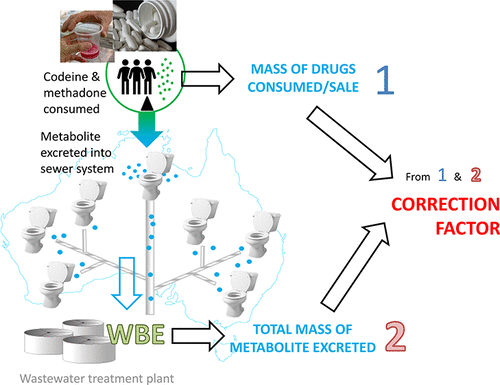当前位置:
X-MOL 学术
›
Environ. Sci. Technol. Lett.
›
论文详情
Our official English website, www.x-mol.net, welcomes your feedback! (Note: you will need to create a separate account there.)
Analyzing Wastewater Samples Collected during Census To Determine the Correction Factors of Drugs for Wastewater-Based Epidemiology: The Case of Codeine and Methadone
Environmental Science & Technology Letters ( IF 10.9 ) Pub Date : 2019-01-02 , DOI: 10.1021/acs.estlett.8b00673 Phong K. Thai 1 , Jake W. O’Brien 1 , Ben J. Tscharke 1 , Jochen F. Mueller 1
Environmental Science & Technology Letters ( IF 10.9 ) Pub Date : 2019-01-02 , DOI: 10.1021/acs.estlett.8b00673 Phong K. Thai 1 , Jake W. O’Brien 1 , Ben J. Tscharke 1 , Jochen F. Mueller 1
Affiliation

|
The correction factor (CF) is a critical parameter for back-estimating the consumption of a drug via wastewater-based epidemiology (WBE). The CF is usually the excretion factor (EF) of the drug or metabolite (the fraction of drug excreted after consumption and the molecular mass ratio of parent drug/metabolite) traditionally determined by human pharmacokinetic studies. An alternative approach to derive CFs is to compare the consumption data with the loads measured by WBE in representative wastewater samples. For this purpose, during the 2016 Australian Census week, more than 500 wastewater samples were collected from 83 wastewater treatment plants across Australia (covering >60% of the Australian population) and analyzed for codeine, methadone, and methadone metabolite, EDDP. National sales data for codeine and methadone to local pharmacies were obtained to estimate the CFs for the three biomarkers. The CFs estimated for codeine and EDDP in this study, 29% (95% CI = 28%–30%) and 50% (95% CI = 49%–52%), respectively, are significantly different from the EFs deduced from pharmacokinetic data (60% and 25%), while methadone’s CF is relatively similar to previously used values (22% vs 27.5%). The newly derived CFs were applied to available data in the literature and produced better matches between estimates and consumption data than previously reported. It is thus suggested that the new approach be used to derive the CFs of other drugs of interest for WBE application when limited pharmacokinetic data are available.
中文翻译:

分析普查期间收集的废水样本,以确定用于基于废水的流行病学的药物校正因子:以可待因和美沙酮为例
校正因子(CF)是通过基于废水的流行病学(WBE)反向估算药物消耗量的关键参数。CF通常是传统上通过人体药代动力学研究确定的药物或代谢物的排泄因子(EF)(食用后排泄的药物比例和母体药物/代谢产物的分子质量比)。得出CFs的另一种方法是将消耗数据与WBE在代表性废水样品中测得的负荷进行比较。为此,在2016年澳大利亚普查周内,从澳大利亚的83个废水处理厂(覆盖了澳大利亚人口的60%以上)收集了500多个废水样品,并分析了可待因,美沙酮和美沙酮代谢物EDDP。获得了可待因和美沙酮在当地药房的全国销售数据,以估算这三种生物标记物的CF。在本研究中,可待因和EDDP的CF值分别估计为29%(95%CI = 28%–30%)和50%(95%CI = 49%–52%),与由药代动力学推导出的EFs显着不同。数据(分别为60%和25%),而美沙酮的CF与以前使用的数值相对相似(22%和27.5%)。新推导的CFs已应用于文献中的可用数据,并且与先前报道的相比,在估计值和消费数据之间产生了更好的匹配。因此,建议在药代动力学数据有限的情况下,可以使用这种新方法来推导用于WBE应用的其他目标药物的CFs。美沙酮的药代动力学分别为29%(95%CI = 28%–30%)和50%(95%CI = 49%–52%),与从药代动力学数据推导出的EFs有显着差异(60%和25%)。 CF与以前使用的值相对相似(22%对27.5%)。新推导的CFs已应用于文献中的可用数据,并且与先前报告的数据相比,估计值和消费数据之间的匹配更好。因此,建议在药代动力学数据有限的情况下,可以使用这种新方法来推导用于WBE应用的其他目标药物的CFs。美沙酮的药代动力学分别为29%(95%CI = 28%–30%)和50%(95%CI = 49%–52%),与从药代动力学数据推导出的EFs有显着差异(60%和25%)。 CF与以前使用的值相对相似(22%对27.5%)。新推导的CFs已应用于文献中的可用数据,并且与先前报告的数据相比,估计值和消费数据之间的匹配更好。因此,建议在药代动力学数据有限的情况下,可以使用这种新方法来推导用于WBE应用的其他目标药物的CFs。新推导的CFs已应用于文献中的可用数据,并且与先前报告的数据相比,估计值和消费数据之间的匹配更好。因此建议,当可获得有限的药代动力学数据时,可以使用新方法来推导其他感兴趣的药物用于WBE的CFs。新推导的CFs已应用于文献中的可用数据,并且与先前报告的数据相比,估计值和消费数据之间的匹配更好。因此,建议在药代动力学数据有限的情况下,可以使用这种新方法来推导用于WBE应用的其他目标药物的CFs。
更新日期:2019-02-07
中文翻译:

分析普查期间收集的废水样本,以确定用于基于废水的流行病学的药物校正因子:以可待因和美沙酮为例
校正因子(CF)是通过基于废水的流行病学(WBE)反向估算药物消耗量的关键参数。CF通常是传统上通过人体药代动力学研究确定的药物或代谢物的排泄因子(EF)(食用后排泄的药物比例和母体药物/代谢产物的分子质量比)。得出CFs的另一种方法是将消耗数据与WBE在代表性废水样品中测得的负荷进行比较。为此,在2016年澳大利亚普查周内,从澳大利亚的83个废水处理厂(覆盖了澳大利亚人口的60%以上)收集了500多个废水样品,并分析了可待因,美沙酮和美沙酮代谢物EDDP。获得了可待因和美沙酮在当地药房的全国销售数据,以估算这三种生物标记物的CF。在本研究中,可待因和EDDP的CF值分别估计为29%(95%CI = 28%–30%)和50%(95%CI = 49%–52%),与由药代动力学推导出的EFs显着不同。数据(分别为60%和25%),而美沙酮的CF与以前使用的数值相对相似(22%和27.5%)。新推导的CFs已应用于文献中的可用数据,并且与先前报道的相比,在估计值和消费数据之间产生了更好的匹配。因此,建议在药代动力学数据有限的情况下,可以使用这种新方法来推导用于WBE应用的其他目标药物的CFs。美沙酮的药代动力学分别为29%(95%CI = 28%–30%)和50%(95%CI = 49%–52%),与从药代动力学数据推导出的EFs有显着差异(60%和25%)。 CF与以前使用的值相对相似(22%对27.5%)。新推导的CFs已应用于文献中的可用数据,并且与先前报告的数据相比,估计值和消费数据之间的匹配更好。因此,建议在药代动力学数据有限的情况下,可以使用这种新方法来推导用于WBE应用的其他目标药物的CFs。美沙酮的药代动力学分别为29%(95%CI = 28%–30%)和50%(95%CI = 49%–52%),与从药代动力学数据推导出的EFs有显着差异(60%和25%)。 CF与以前使用的值相对相似(22%对27.5%)。新推导的CFs已应用于文献中的可用数据,并且与先前报告的数据相比,估计值和消费数据之间的匹配更好。因此,建议在药代动力学数据有限的情况下,可以使用这种新方法来推导用于WBE应用的其他目标药物的CFs。新推导的CFs已应用于文献中的可用数据,并且与先前报告的数据相比,估计值和消费数据之间的匹配更好。因此建议,当可获得有限的药代动力学数据时,可以使用新方法来推导其他感兴趣的药物用于WBE的CFs。新推导的CFs已应用于文献中的可用数据,并且与先前报告的数据相比,估计值和消费数据之间的匹配更好。因此,建议在药代动力学数据有限的情况下,可以使用这种新方法来推导用于WBE应用的其他目标药物的CFs。


























 京公网安备 11010802027423号
京公网安备 11010802027423号